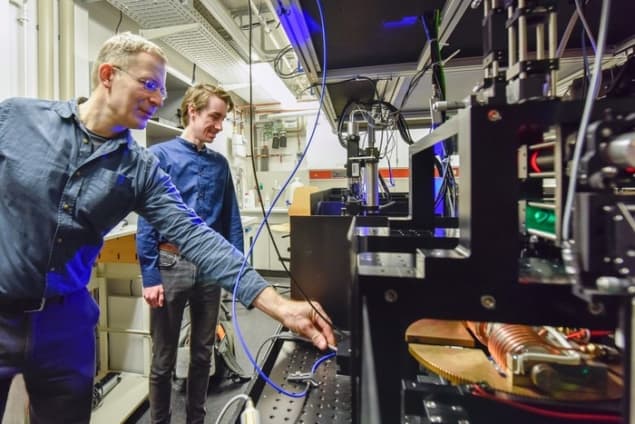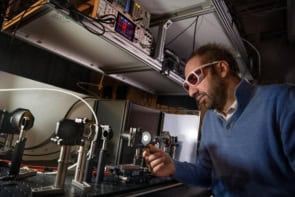
A simple method for multiplying the frequencies of spin waves in magnetic materials from the megahertz range all the way into the gigahertz has been serendipitously discovered by researchers in Germany. The research opens new avenues in the study of spin waves and provides laboratory researchers with a simple means to generate a wide variety of spin wave frequencies. Moreover, it could also prove to be a step towards the use of spintronics in commercial devices.
Frequency multiplication using technologies such as non-linear circuitry is a crucial element of everyday electronics. Mobile phones and satellite communication devices, for example, have internal circuitry that operates at megahertz frequencies but they receive and transmit signals at gigahertz frequencies.
However, one problem with today’s electronics devices is the resistive heat that must be dissipated when information-carrying electrical currents flow through circuits. This makes cooling ever-more tightly packed computer processors difficult and means that, as electronics becomes more pervasive, its energy footprint grows remorselessly. At present 10% of the world’s electricity is consumed by digital technology.
Low-energy solution
One potential solution to this energy problem is spintronics in which signals could be carried by spin waves – which are fluctuations in the intrinsic magnetic moments of an ensemble of electrons. In this scenario the electrons themselves do not move, so there is no resistive heating.
“In principle, you can translate spin, and in principle, you can transport spin currents with much lower dissipation than you can with charge currents,” explains Georg Woltersdorf of Martin Luther University Halle-Wittenberg in Germany. Spintronics could also be used in other useful applications such as non-volatile memory. Among the many challenges, however, is that no technologies currently available can multiply spin wave frequencies.
While studying a different problem, Woltersdorf and colleagues pumped a nickel-iron magnet using the radiofrequency magnetic field from a coplanar waveguide. When they analysed the resulting oscillations with diamond nitrogen-vacancy centres, they noticed something bizarre: “There were some lines in the photoluminescence spectra of these diamond NV centres that we just couldn’t explain,” says Woltersdorf, “At first we thought there was something wrong with our frequency source.” In fact, some of these lines have been seen in previous experiments from other groups, which have concluded exactly this.
Multiple harmonics
After testing their source thoroughly, however, the researchers concluded the lines could only be coming from the material itself. The researchers investigated the effect further using an alternative technique called time-resolved magneto-optic Kerr microscopy. They found that the material was behaving like an extremely large frequency comb, generating up to the 50th harmonic of the fundamental frequency and thereby producing frequencies into the gigahertz range when pumped at megahertz frequencies.
“We have a sinusoidal excitation, but the magnetization responds almost in a digital fashion,” says Woltersdorf; “It will just snap periodically, and if you look at the Fourier transform, it gives you a frequency comb.”
Theoretical analysis led the researchers to conclude that the phenomenon results from switching magnetic domains exchanging spin waves and thereby becoming synchronized. Woltersdorf compares this to the tidal locking of moons orbiting a planet or Belousov–Zhabotinsky reactions in chemistry, which oscillate back and forth. “It tends to happen when you have a non-linear means of communication between different elements of a system. In the case of moons, it’s gravitational force; in oscillating chemical reactions in a beaker, it’s the quantity of reactants you have. It’s like that with spin waves.”
Source of spin waves
The researchers are now investigating the underlying physics behind the phenomenon more deeply. They hope to measure the ultimate limits of the effect in nickel-iron and see if even higher harmonics can be generated in other materials. Beyond this, they would like to develop the phenomenon as a useful source of high-frequency spin waves for laboratory experiments. As for spintronics, “Whether or not one can then come up with spin-based electronics that has significant-enough advantages over conventional electronics…That’s beyond my abilities,” concludes Woltersdorf.

Electric fields control spintronics devices
Chris Hammel of Ohio State University describes the results as “quite remarkable”, adding, “Spin textures are of very intense interest and importance right now, and this is a form of spin texture that I’ve not really seen – a dynamical spin texture that only exists in this very deeply non-linear regime of intense spin waves. There will be a lot of things people will want to do with this.”
Gregory Fuchs of Cornell University in New York is equally surprised: “The first part of the paper I thought ‘This is probably bogus’,” he says; “Then they did some follow-up experiments that I don’t have a good way of disputing, and they have a micromagnetic model that explains the phenomena, so I think it’s actually correct. That makes it very interesting. Whether it’s important is defined by what happens next.”
The research is described in Science.



